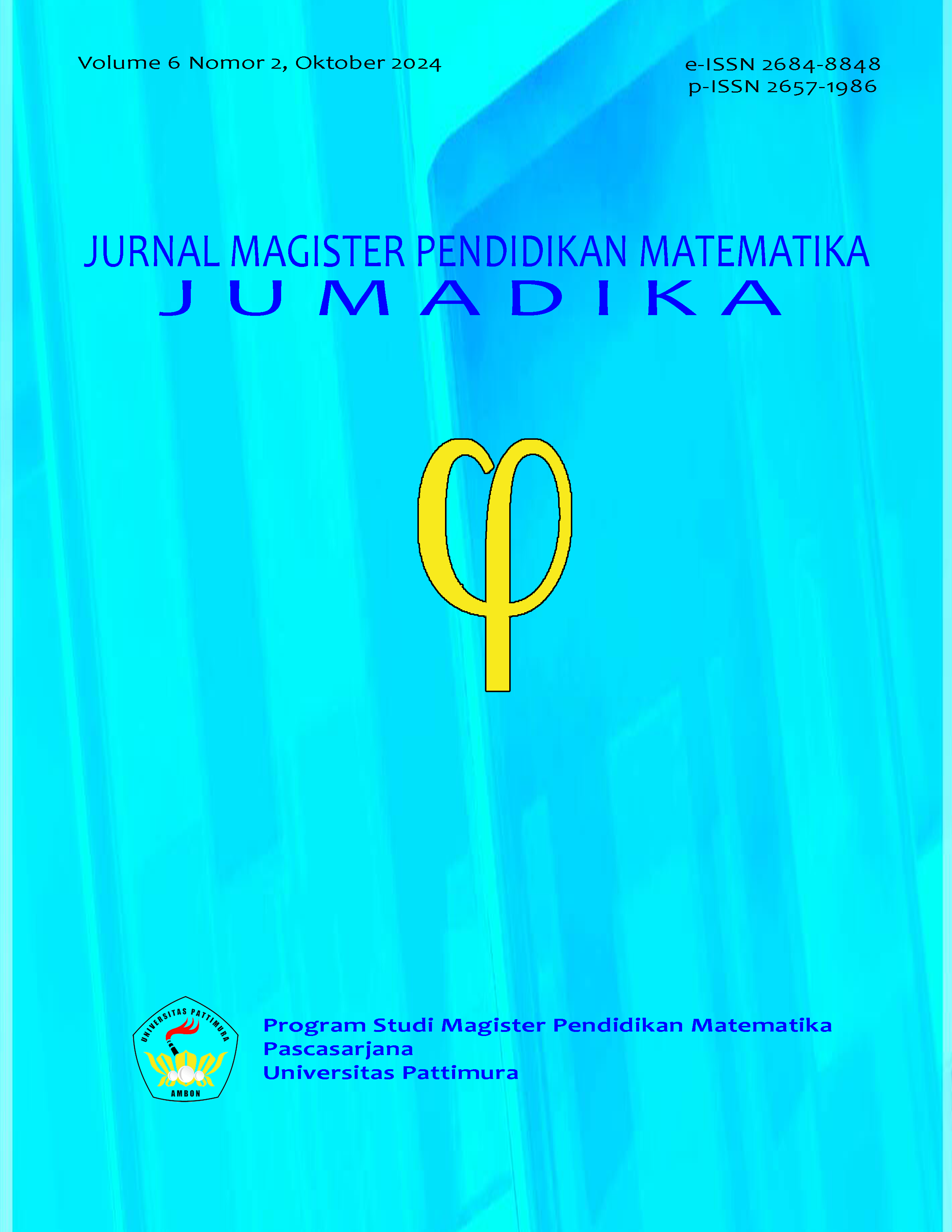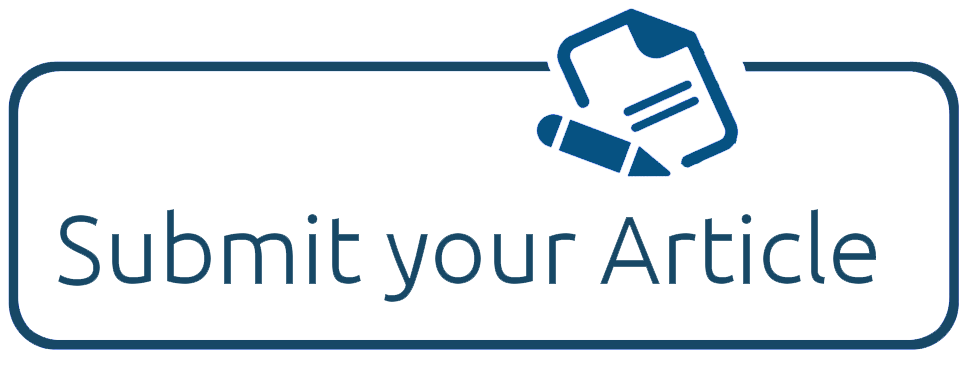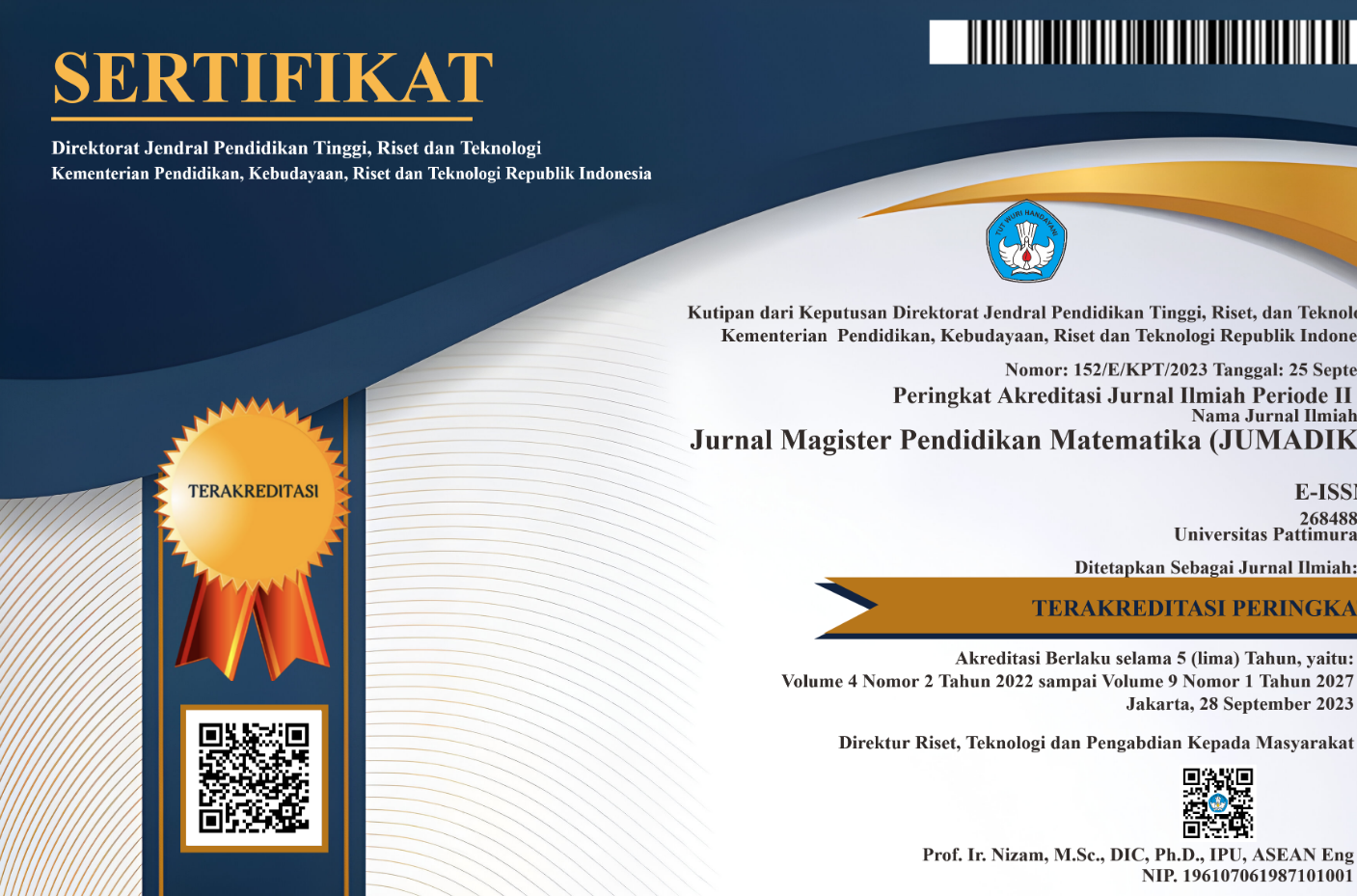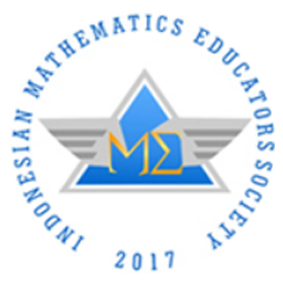STUDENTS' MATHEMATICAL REPRESENTATION AND REASONING SKILLS THROUGH AN ETHNOMATHEMATICS-BASED RME APPROACH
Abstract
This study was conducted to obtain an overview of the differences between ethnomathematics-based and conventional RME models on students' mathematical representation and reasoning abilities on curved-sided space building material. Researchers used quantitative research methods. This research is aquasi experiment with pretest postest research design conducted on grade IX students of SMP Negeri 1 Seram Barat. The samples of this study were students of class IX A. and IX E, consisting of 29 students for each class, which were taken by non-random sampling or purposive sampling. The experimental class used the ethnomathematics-based RME learning model while the control class used the conventional learning model. The research data were obtained through written tests in the experimental and control classes. The normality test showed that the data in both groups were normally distributed. The data homogeneity test also shows that the data in both groups are homogeneous. The results of the independent t-test showed that there was a difference in the average representation and reasoning skills of the experimental class as well as the control class, with a sig value of 0.00 <0.05. The N-gain test shows the effectiveness of the learning provided. The experimental class with representation ability has an average N-gain of 0.08 (high category) > 0.45 (medium category) for the control class. In the reasoning ability of the experimental class with an average of 0.83 (high category) > 0.28 (low category) for the control class
Downloads
References
Agustinayanti. (2022). Pengembangan Nalar-Logika Realistik Matematis Siswa Berbasis EtnoMatematika dan Cooperatif Learning di Sekolah Menengah Kejuruan Negeri (SMKN) 1 Singgahan-Tuban. Elektriese: Jurnal Sains danTeknologiElektro,49-62.doi:https://doi.org/10.47709/elektriese.v12i1.1559
Ahmad, H. (2015). Peningkatan Kemampuan Penalaran Matematika Materi Trigonometri Melalui Penerapan Model Pembelajaran Discovery Learning dengan Pendekatan Saintifik pada Kelas X SMA Negeri 11 Makasar. Jurnal Daya Matematis, 3(3), 299-307.
Ainy, S., Shoffa, M., & Soemantri, M, S. (2019). Pengaruh Model Pembelajaran Kooperatif Tipe Numbered Head Together (NHT) Terhadap Kemampuan Pemecahan Masalah Matematika Siswa Kelas VII SMP Negeri 1 Cikarang Utara. Jurnal Pendidikan Matematika, 13(2), 1-101
Aprilianingsih, N. Z., & Yayuk, R. (2019). Ethnomatematika Budaya Purbalingga Dalam Pembelajaran Matematika. PROSIDING SENDIKA, 5(1).
Campbell, D.T & Stanley, J. C. (1966). Experimental and quasi-experimental designs for research. Chicago: Rand McNally & Co.
D’Ambrosio, U. (1989). Etnomatematika: Matematika dalam Suatu Budaya.
Duval, R. (2017). Representation, Vision and Visualization: Cognitive Functions in Mathematical Thinking. Dalam Visualization in Mathematics, Reading and Science Education (hlm. 3-26). Springer.
Febriani, P., Widada, W., & Herawaty, D. (2019). Pengaruh Pembelajaran Matematika Realistik Berbasis Etnomatematika Terhadap Kemampuan Pemahaman Konsep Matematika Siswa SMA Kota Bengkulu. Jurnal Pendidikan Matematika Raflesia, 4(2),120–135. https://doi.org/10.33369/jpmr.v4i2.9761
Goldin, G. A. (2020). Representation in Mathematical Learning and Problem Solving. In Handbook of Research on Mathematics Teaching and Learning (pp. 2-45). Routledge.
Hake, R.R. (1998). Interactive-engagement versus traditional methods: A six-thousand- student survey of mechanics test data for introductory physics courses. American Journal of Physics, (66) 64. doi: 10.1119/1.18809.
Herlanti, Y. (2016). Jawab Seputar Penelitian Pendidikan Sains.
Heryan, U. (2018). Meningkatkan Kemampuan Komunikasi Matematis Siswa SMA Melalui Pendekatan Pembelajaran Matematika Realistik Berbasis Etnomatematika. Jurnal Pendidikan Matematika Raflesia, 3(2), 94–106.
Laurens, T. (2016). Analisis Etnomatematika dan Penerapannya dalam Meningkatkan Kualitas Pembelajaran. Jurnal Pendidikan Matematika STKIP PGRI Sumbar, 3(1), 86-96.
Laurens, T., Laamena, C., & Matitaputty, C. (2014). Development a set of instructional based realistic mathematics education and local wisdom. In Intenational Seminar on Innovation in Mathematics and Matematics Education (pp. 571-576).
Lesnusa A., Rumlawang F.,Ilwaru V.,& Matital L., (2021) Etnomatematika Kajian Budaya Maluku, Satuan ukuran Traditional . Banyumas, Jawah Tenga, Wawasan Ilmu.
Lestari, D. A., & Surya, E. (2017). Pengaruh Model Pembelajaran Kooperatif Tipe Numbered Head Together (NHT) Terhadap Kemampuan Pemecahan Masalah Matematika Siswa Kelas VII SMP Negeri 1 Cikarang Utara. Jurnal Pendidikan Matematika, 13(2), 1-10.
Melisa, dkk., (2019), Pembelajaran Matematika Realistik Berbasis Etnomatematika Bengkulu untuk Meningkatkan Kognisi Matematis, Jurnal PendidikanMatematika Raflesia, Vol. 04, No. 02.
Meltzer, (2002) “The Relationship Between Mathematics Preparation and Conceptual learning gains in Physics”.
Mukeriyanto, M., et al. (2020). Pengaruh Model Pembelajaran Kooperatif Tipe Numbered Head Together (NHT) Terhadap Kemampuan Pemecahan Masalah Matematika Siswa Kelas VII SMP Negeri 1 Cikarang Utara. Jurnal Pendidikan Matematika, 13(2), 1-10.
Purwanto. (2009). Evaluasi Hasil Belajar. Yogyakarta: Pustaka Pelajar
Rahman, A. (2017). Pengaruh Model Pembelajaran Kooperatif Tipe Numbered Head Together (NHT) Terhadap Kemampuan Pemecahan Masalah Matematika Siswa Kelas VII SMP Negeri 1 Cikarang Utara. Jurnal Pendidikan Matematika, 13(2), 1-102
Ratumanan, T. G. (2015). Inovasi pembelajaran (mengembangkan kompetensi peserta didik secara optimal. Penerbit Ombak.
Ratumanan, T. G., & Laurens, T. (2015). Penilaian Hasil Belajar Pada Tingkat Satuan Pendidikan Edisi Ke 3. Yogyakarta : Pensil Komunika.
Ratumanan, T. G.,& Rosmiati, I. (2019). Perencanaan pembelajaran. PT Raja Grafindo Persada.
Sudjana, (2005). Metode Statistik. Tarsinto
Sutrisno, S., & Kharisudin, E. (2020). Pengaruh Model Pembelajaran Kooperatif Tipe Numbered Head Together (NHT) Terhadap Kemampuan Pemecahan Masalah Matematika Siswa Kelas VII SMP Negeri 1 Cikarang Utara. Jurnal Pendidikan Matematika, 13(2), 1-103
Tarigan, A. (2006). Pengaruh Pendekatan Realistic Mathematic Education (RME) terhadap Kemampuan Pemahaman Konsep dan Kemampuan Pemecahan Masalah Matematis Siswa Sekolah Menengah Pertama. Jurnal Pendidikan Matematika, 1(1), 1-10.
Turmudi. (2008). Peningkatan Kemampuan Penalaran Matematis Siswa Melalui Pembelajaran Berbasis Masalah. Jurnal Pendidikan Matematika, 1(1), 1-10.
Wihdan. (2020, 27 Agustus). PISA Rendah, Pengamat: Kemampuan Matematika Tergantung Guru. Diakses dari https://republika.co.id/berita/q4k9v8349/pisa-rendahpengamat-kemampuan-matematika-tergantung-guru.
Copyright (c) 2024 Luis Matital, Tanwey G Ratumanan, Christina M Laamena

This work is licensed under a Creative Commons Attribution-NonCommercial-ShareAlike 4.0 International License.
License and Copyright Agreement
In submitting the manuscript to the journal, the authors certify that:
- They are authorized by their co-authors to enter into these arrangements.
- The work described has not been formally published before, except in the form of an abstract or as part of a published lecture, review, thesis, or overlay journal. Please also carefully read Jurnal Magister Pendidikan Matematika (JUMADIKA) Posting Your Article Policy.
- That it is not under consideration for publication elsewhere,
- That its publication has been approved by all the author(s) and by the responsible authorities – tacitly or explicitly – of the institutes where the work has been carried out.
- They secure the right to reproduce any material that has already been published or copyrighted elsewhere.
- They agree to the following license and copyright agreement.
Copyright
Authors who publish with Jurnal Magister Pendidikan Matematika (JUMADIKA) agree to the following terms:
- Authors retain copyright and grant the journal right of first publication with the work simultaneously licensed under a Creative Commons Attribution-NonCommercial-ShareAlike 4.0 International License (http://creativecommons.org/licenses/by-nc-sa/4.0/) that allows others to share the work with an acknowledgment of the work's authorship and initial publication in this journal.
- Authors are able to enter into separate, additional contractual arrangements for the non-exclusive distribution of the journal's published version of the work (e.g., post it to an institutional repository or publish it in a book), with an acknowledgment of its initial publication in this journal.
- Authors are permitted and encouraged to post their work online (e.g., in institutional repositories or on their website) prior to and during the submission process, as it can lead to productive exchanges, as well as earlier and greater citation of published work.








